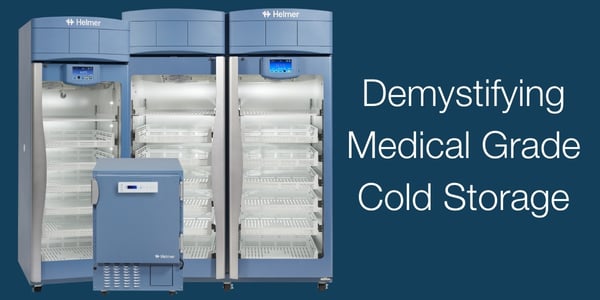Welcome to part two of our three-part series dedicated to outlining the performance, features, and certifications that set medical-grade cold storage equipment apart from standard-, food-, or commercial-grade refrigerators and freezers.
In part one, we highlighted the temperature performance standards medical-grade equipment should be measured against. These baseline performance measurables ensure a refrigerator or freezer is up to the task of storing critical medications, vaccines, and other temperature-sensitive materials in a clinical setting.
Part two is all about critical features. We’ll outline what components and product features should be considered when evaluating medical-grade cold storage equipment.
While the features and benefits of medical-grade cold storage equipment vary from manufacturer to manufacturer, there are a few features every medical-grade refrigerator or freezer should have.
These features ensure accessibility and visibility into the performance of the units, and they indicate the equipment has been designed and manufactured for the application it is intended to support.
Capable Refrigeration Technology
While specific application requirements may vary, all refrigerators and freezers used in clinical applications need to ensure the refrigeration systems at work have been specifically engineered to meet the demands of the clinical space.
- Forced Air Convection: Where possible, medical-grade cold storage equipment should use forced-air convection refrigeration technology. Forced-air convection technology provides the precision temperature performance necessary to store high-value medications, vaccines, and biological samples.
- Advanced Compressor Technology: A primary consideration when choosing medical-grade cold storage equipment is whether the compressors utilized by the units have been proven in healthcare applications. Medical-grade refrigerator and freezer compressors need to be able to provide consistent performance over a long service life, which includes consistent and frequent door openings, fluctuations in ambient environment, and varying inventory loads.
- Condensation Management: A common challenge medical-grade cold storage equipment faces is condensation. Because medical-grade equipment is often accessed frequently, the interior of the cabinet is exposed to warm, humid air, which results in condensation development. High-performance cold storage equipment should provide a system for safely collecting and evaporating excess moisture.
- Sustainable Refrigerants: All medical-grade cold storage equipment should use low-GWP refrigerants. These alternative refrigerants provide a sustainable option without sacrificing performance.
Critical Alarms
A few other key differentiators between medical-grade cold storage equipment and non-medical-grade units is how the refrigerator or freezer notifies a user about current conditions. Whether it is adhering to NSF/ANSI 456 or CDC best practices, refrigerators and freezers should provide critical alarm capabilities. Basic alarm functionality should include temperature excursion, door ajar, and power failure.
High performance equipment manufacturers may provide advanced alarm features, such as alerting when there is a temperature probe failure and the ability to automate alarm tests.
Application Compatibility and Product Configurability
Medical-grade cold storage is an investment. When making such an investment, you should have confidence that the unit you choose can meet your needs and withstand the rigors that come with service in clinical settings.
- Cleanser Compatibility: Medical-grade units are regularly cleaned with strong, bleach-based cleansers. If they are not designed to withstand regular exposure to these cleaning agents, the units may be damaged. Equipment manufacturers should be able to provide data that confirms the components in their refrigerators and freezers have been tested to withstand exposure to the cleaning products used in your facility without compromising the integrity or functionality of the equipment.
- Configurable Material Handling: Internal storage should be configurable to meet specific application or workflow requirements. Manufacturers of high-performance medical-grade units should be able to provide shelves or drawers based on your facilities needs.
Advanced High-Performance Features
True high-performance medical-grade refrigerators and freezers often come with additional features that support healthcare applications.
- Integrated Access Control: This feature requires a PIN to access the cabinet and provides an additional layer of security to prevent unnecessary or unauthorized access to your inventory.
- Solid Thermal Ballast Technology: Solid thermal ballasts eliminate the use of a glycerin probe bottle in +4°C refrigerators without sacrificing performance or visibility. By eliminating the glycerin bottle, you eliminate one additional administrative step from your team’s workflow and reduce the risk of nuisance alarms.
- Exportable Reports & Graphs: Some applications require the ability of a refrigerator or freezer to track performance and alarm conditions in an exportable format. This capability supports compliance workflows and replaces or provides a redundancy for traditional paper logs.
Other Blogs You Might Be Interested In...
- Demystifying Medical-Grade Cold Storage: Part 1
- Temperature Probes: The Benefits of a Solid Thermal Ballast
- Downloadable Temperature Graphs and Event Reports Support Compliance
- Cybersecurity Check-in: i.Series Equipment Passes Vulnerability Testing
Refrigerators and freezers from Helmer Scientific are the first true medical-grade cold storage equipment designed specifically and exclusively for use in clinical and life science research settings.
We published a white paper to provide additional information about what defines medical-grade cold storage and the value it adds in clinical settings.





